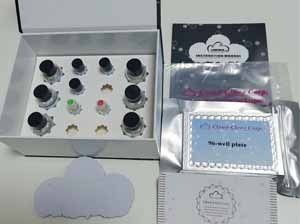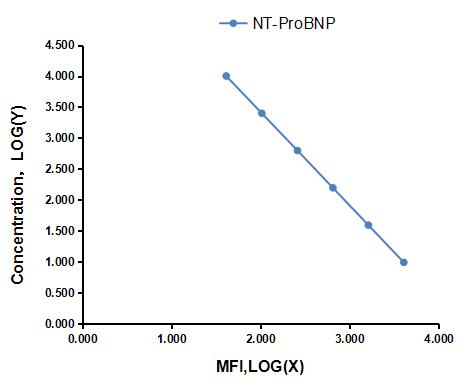Multiplex Assay Kit for N-Terminal Pro-Brain Natriuretic Peptide (NT-ProBNP) ,etc. by FLIA (Flow Luminescence Immunoassay) 

NT-Pro-BNP; ; N-BNP
(Note: Up to 8-plex in one testing reaction)
- UOM
- FOB US$ 468.00 US$ 486.00 US$ 513.00 US$ 549.00 US$ 585.00 US$ 639.00 US$ 720.00 US$ 900.00
- Quantity
Overview
Properties
- Product No.LMA485Ga
- Organism SpeciesChicken (Gallus) Same name, Different species.
- ApplicationsFLIA Kit for Antigen Detection.
Research use only - DownloadInstruction Manual
- CategoryEndocrinologyCardiovascular biology
Sign into your account
Share a new citation as an author
Upload your experimental result
Review

Contact us
Please fill in the blank.
Recovery
Matrices listed below were spiked with certain level of recombinant N-Terminal Pro-Brain Natriuretic Peptide (NT-ProBNP) ,etc. by FLIA (Flow Luminescence Immunoassay) and the recovery rates were calculated by comparing the measured value to the expected amount of N-Terminal Pro-Brain Natriuretic Peptide (NT-ProBNP) ,etc. by FLIA (Flow Luminescence Immunoassay) in samples.
| Matrix | Recovery range (%) | Average(%) |
| serum(n=5) | 80-96 | 89 |
| EDTA plasma(n=5) | 86-98 | 89 |
| heparin plasma(n=5) | 97-105 | 101 |
Precision
Intra-assay Precision (Precision within an assay): 3 samples with low, middle and high level N-Terminal Pro-Brain Natriuretic Peptide (NT-ProBNP) ,etc. by FLIA (Flow Luminescence Immunoassay) were tested 20 times on one plate, respectively.
Inter-assay Precision (Precision between assays): 3 samples with low, middle and high level N-Terminal Pro-Brain Natriuretic Peptide (NT-ProBNP) ,etc. by FLIA (Flow Luminescence Immunoassay) were tested on 3 different plates, 8 replicates in each plate.
CV(%) = SD/meanX100
Intra-Assay: CV<10%
Inter-Assay: CV<12%
Linearity
The linearity of the kit was assayed by testing samples spiked with appropriate concentration of N-Terminal Pro-Brain Natriuretic Peptide (NT-ProBNP) ,etc. by FLIA (Flow Luminescence Immunoassay) and their serial dilutions. The results were demonstrated by the percentage of calculated concentration to the expected.
| Sample | 1:2 | 1:4 | 1:8 | 1:16 |
| serum(n=5) | 84-105% | 84-92% | 84-105% | 90-99% |
| EDTA plasma(n=5) | 98-105% | 79-104% | 95-105% | 78-96% |
| heparin plasma(n=5) | 82-101% | 89-97% | 86-96% | 82-91% |
Stability
The stability of kit is determined by the loss rate of activity. The loss rate of this kit is less than 5% within the expiration date under appropriate storage condition.
To minimize extra influence on the performance, operation procedures and lab conditions, especially room temperature, air humidity, incubator temperature should be strictly controlled. It is also strongly suggested that the whole assay is performed by the same operator from the beginning to the end.
Reagents and materials provided
| Reagents | Quantity | Reagents | Quantity |
| 96-well plate | 1 | Plate sealer for 96 wells | 4 |
| Pre-Mixed Standard | 2 | Standard Diluent | 1×20mL |
| Pre-Mixed Magnetic beads (22#:NT-ProBNP) | 1 | Analysis buffer | 1×20mL |
| Pre-Mixed Detection Reagent A | 1×120μL | Assay Diluent A | 1×12mL |
| Detection Reagent B (PE-SA) | 1×120μL | Assay Diluent B | 1×12mL |
| Sheath Fluid | 1×10mL | Wash Buffer (30 × concentrate) | 1×20mL |
| Instruction manual | 1 |
Assay procedure summary
1. Preparation of standards, reagents and samples before the experiment;
2. Add 50μL standard or sample to each well,
add 10μL magnetic beads,and 50μL Detection Reagent A,incubate 60min at 37°C on shaker;
3. Wash plate on magnetic frame for three times;
4. Add 100μL prepared Detection Reagent B, and incubate 30 min at 37°C on shaker;
5. Wash plate on magnetic frame for three times;
6. Add 100μL sheath solution, swirl for 2 minutes, read on the machine.

Test principle
Analyte-specific antibodies are pre-coated onto color-coded microparticles. Microparticles, standards,Labeled antigen and samples are pipetted into wells and the immobilized antibodies bind the analytes of interest.A competitive inhibition reaction is launched between biotin labeled analytes of interest and unlabeled analytes of interest (Standards or samples) with the pre-coated antibody specific to analytes of interest. Following a wash to remove any unbound substances, Streptavidin-Phycoerythrin conjugate (Streptavidin-PE) is added to each well. A final wash removes unbound Streptavidin-PE and the microparticles are resuspended in buffer and read using the Luminex or Bio-Plex analyzer. The MFI developed is reverse proportional to the concentration of analytes of interest in the sample.
Giveaways
Increment services
Citations
- The role of serum n-terminal pro-brain natriuretic peptide in transient tachypnea of the newbornEuropeanreview: Source
- Vascular Adhesion Protein-1, a Novel Molecule, in Kidney and Heart Allograft RecipientsPubmed: 23769096
- Paradoxical low-flow, low-gradient aortic stenosis despite preserved left ventricular ejection fraction: new insights from weights of operatively excised aortic valvesPubmed: 24755006
- A Randomized Controlled Trial to Study the Effect of Yoga Therapy on Cardiac Function and N Terminal Pro BNP in Heart FailureNCBI: PMC3981569
- Diabetes enhances the intrahepatic vascular response to endothelin-1 in cirrhotic rats: association with the ETA receptor and pERK up-regulation.Pubmed:24636620
- Growth-differentiation factor 15 and osteoprotegerin in acute myocardial infarction complicated by cardiogenic shock: a biomarker substudy of the IABP-SHOCK II-trial.Pubmed:24903195
- Biomarkers and Echocardiographic Predictors of Myocardial Dysfunction in Patients with HypertensionPubMed: 25747153
- The Multi-Biomarker Approach for Heart Failure in Patients with HypertensionPubMed: 25984599
- Effect of Treatment on Body Fluid in Patients with Unilateral Aldosterone Producing Adenoma: Adrenalectomy versus SpironolactonePubMed: 26477337
- Diabetes enhances the intrahepatic vascular response to endothelin‐1 in cirrhotic rats: association with the ETA receptor and pERK up‐regulationPubMed: 24636620
- Qiliqiangxin improves cardiac function and attenuates cardiac remodeling in rats with experimental myocardial infarctionPubMed: 26261541
- NT-proBNP in Children With Left to Right Shunt and Dilated Cardiomyopathyserve:4485
- Human myoblast transplantation in mice infarcted heart alters the expression profile of cardiac genes associated with left ventricle remodelingPubmed:26457413
- Cardiovascular changes in patients with non-severe Plasmodium vivax malariaarticle:S2352-9067(16)30010-0
- Soluble Glycoprotein 130 and Heat Shock Protein 27 as Novel Candidate Biomarkers of Chronic Heart Failure with Preserved Ejection FractionPubmed:27067668
- Differences in biochemical and genetic biomarkers in patients with heart failure of various etiologies.pubmed:27448535
- Expression of pericardial fluid T-cells and related inflammatory cytokines in patients with chronic heart failure.pubmed:28565777
- Effect of Cardiac Resynchronization Therapy on Myocardial Fibrosis and Relevant Cytokines in a Canine Model With Experimental Heart Failure.pubmed:28127817
- Study of Vitamin D Status in Patients with Dilated Cardiomyopathy at a Teaching Hospital in North India.pubmed:28465969
- 5-methoxytryptophan is a potential marker for post-myocardial infarction heart failure - apreliminary approach to clinical utility.pubmed:27526355
- Beneficial Effects of Ozone Therapy on Oxidative Stress, Cardiac Functions and Clinical Findings in Patients with Heart Failure Reduced Ejection Fractionpubmed:28097518
- Serial heart rhythm complexity changes in patients with anterior wall ST segment elevation myocardial infarction.pubmed:28252107
- The predictive capabilities of a novel cardiovascular magnetic resonance derived marker of cardiopulmonary reserve on established prognostic surrogate markers in patients with pulmonary vascular disease: results of a longitudinal pilot studypubmed:28065166
- AVALIAÇÃO ELETROCARDIOGRÁFICA AMBULATORIAL DE CÃES COM EHRLIQUIOSE MONOCÍTICA CRÔNICAhandle:11449
- Cardiac biomarkers in dogs with visceral leishmaniasisS0301-732X2016000300004
- Evaluation of N-Terminal Pro Brain Natriuretic Peptide as a biomarker for clinical severity of heart failure in pediatric populationAttach432
- Cardioprotection against Heart Failure by Shenfu Injection via TGF-β/Smads Signaling Pathwaypubmed:28698735
- QSKL protects against myocardial apoptosis on heart failure via PI3K/Akt-p53 signaling pathway.pubmed:29209026
- Reversal effects of low-dose imatinib compared with sunitinib on monocrotaline-induced pulmonary and right ventricular remodeling in ratspubmed:29100963
- Qiliqiangxin Enhances Cardiac Glucose Metabolism and Improves Diastolic Function in Spontaneously Hypertensive Ratspubmed:28706558
- Prediction of electro-anatomical substrate using APPLE score and biomarkersPubmed:29893827
- Role of NT-proANP and NT-proBNP in patients with atrial fibrillation: Association with atrial fibrillation progression phenotypesPubmed:29604419
- MicroRNAs in Peripheral Mononuclear Cells as Potential Biomarkers in Hypertensive Patients With Heart Failure With Preserved Ejection FractionPubmed:29506053
- Differential microRNA expression profiles and bioinformatics analysis between young and aging spontaneously hypertensive ratsPubmed:29328372
- Regulation of circulating chromogranin B levels in heart failurePubmed:29098879
- Effect of 6-min Walk Test on pro-BNP Levels in Patients with Pulmonary Arterial HypertensionPubmed:29564533
- Dynamic monitoring the level of NT-proBNP in assessing the value of cardiac function and prognosis in patients with systemic infectionijcem0072283.pdf
- Signature-oriented investigation of the efficacy of multicomponent drugs against heart failurePubmed: 30230922
- Qiliqiangxin ameliorates cardiac dysfunction in heart failure rats post myocardial infarction via activation of HIF/VEGF pathway
- Decreasing cardiac iron overload with Amlodipine and Spirulina in children with β-thalassemiaDoi: 10.1016/j.phoj.2018.10.001
- Acute Responses of Novel Cardiac Biomarkers to a 24-h Ultra-MarathonPubmed: 30625976
- Relationship between Natriuretic Peptide Levels with Heart and Kidney Parameters in Rats with Chronic Renal Failure.
- Biological markers for the effects of yoga as a complementary and alternative medicinePubmed: 30735481
- Trimetazidine Attenuates Exhaustive Exercise-Induced Myocardial Injury in Rats via Regulation of the Nrf2/NF-κB Signaling PathwayPubmed: 30890937
- Potential Effects of CXCL9 and CCL20 on Cardiac Fibrosis in Patients with Myocardial Infarction and Isoproterenol-Treated RatsPubmed: 31083544
- Evaluation of heart rate variability and behavior of electrocardiographic parameters in dogs affected by chronic Monocytic EhrlichiosisPubmed: 31125348
- Cardio-protective effect of the secretome of Sca-1+ and Sca-1-cells in heart failure–not equal, but equally important? Paracrine cell effects on heart failure
- The potential role of inflammation in cryptogenic stroke
- Arterial Stiffness and Indices of Left Ventricular Diastolic Dysfunction in Patients with Embolic Stroke of Undetermined EtiologyPubmed: 31612072
- Hormonal Response to Incremental and Continuous Exercise in Cyclists with Left Ventricle HypertrophyPubmed: 32148580
- Preclinical development of a miR-132 inhibitor for heart failure treatmentPubmed: 32005803
- Evaluating the Relationship of GDF-15 with Clinical Characteristics, Cardinal Features, and Survival in Multiple MyelomaPubmed: 33144847
- CDR132L improves systolic and diastolic function in a large animal model of chronic heart failurePubmed: 33089304
- Omega-3 polyunsaturated fatty acids alleviate hydrogen sulfide-induced blood-testis barrier disruption in the testes of adult micePubmed: 33068716
- Apela improves cardiac and renal function in mice with acute myocardial infarctionPubmed: 32686917
- Left Ventricular Diastolic Dysfunction as Predictor of Unfavorable Prognosis After ESUS33727824
- κ Opioid Receptor Agonist Inhibits Myocardial Injury in Heart Failure Rats through Activating Nrf2/HO-1 Pathway and Regulating Ca2+-SERCA2a34373768
- Hemodynamic Responses in Lower Limb Lymphedema Patients Undergoing Physical Therapy34356497
- Risk Stratification of Pulmonary Thromboembolism using Brain Natriuretic Peptide and Troponin I; a Brief ReportPubmed:35072097
- Interplay between mineral bone disorder and cardiac damage in acute kidney injury: from Ca2+ mishandling and preventive role of Klotho in mice to its potential …Pubmed:35077866
- The Key Role of Hepcidin-25 in Anemia in Multiple Myeloma Patients with Renal ImpairmentPubmed:35334593
- Prothymosin α Gene Transfer Modulates Myocardial Remodeling after Ischemia-Reperfusion InjuryPubmed:35273440







